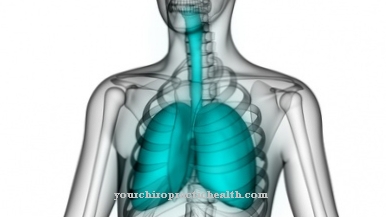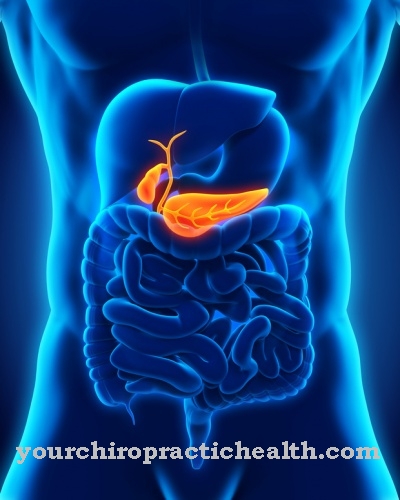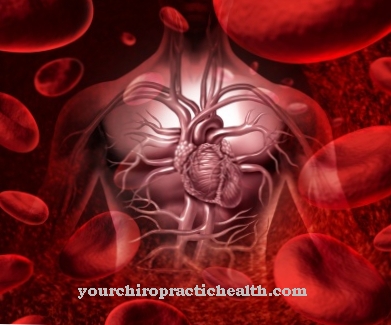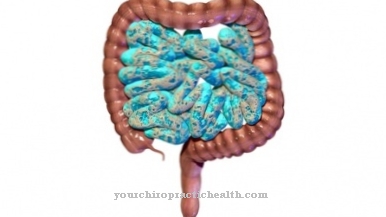Of the Citric acid cycle is a cycle of biochemical reactions that is used to break down organic substances. The process is embedded in the overall metabolism and takes over about half of the energy production. If the citric acid cycle is disturbed, mitochondrial disease may be present.
What is the citric acid cycle?

The citric acid cycle is a metabolic breakdown pathway and as such plays an important role in cell metabolism. He will too Citric Acid Cycle called and corresponds to a cycle of biochemical reactions. The center of the citric acid cycle is oxidation, during which substances are broken down by releasing electrons.
In this way, organic substances are broken down in the citric acid cycle in order to be able to provide intermediate products for biosynthesis. In living beings whose cells have a nucleus, the citric acid cycle takes place in the mitochondrial matrix of the cells. In all other living things, it is located in the cytoplasm.
If the citric acid cycle takes place in reverse order, it is called the reductive citric acid cycle. Such a reductive citric acid cycle occurs, for example, in the assimilation of carbon in the body of various bacteria.
The citric acid cycle owes its name to citrate, which is known as the anion of citric acid. Hans A. Krebs was the first to describe the citric acid cycle, so that the cycle is also called the Krebs cycle.
Function & task
The citric acid cycle provides the human organism with intermediate products for the construction of organic components. In addition, it supplies people with energy directly and indirectly in biochemical form. The breakdown pathways of protein, fat and carbohydrate metabolism meet in the citric acid cycle in the form of activated acetic acid.
When sugars, fats and amino acids are broken down, acetyl-CoA is formed as an intermediate product. This acetyl-CoA is broken down into CO2 and H2O in the citric acid cycle. The first step is a condensation. A C-2 molecule from acetyl-CoA is condensed together with a C-4 molecule to citrate, i.e. to a C-6 molecule. This C-6 citrate is now broken down. The degradation takes place with a double release of CO2 and creates the C-4 compound succinate. This is followed by two-stage oxidation. The C-4 compound becomes oxaloacetate and a new cycle can begin.
After each cycle there is an acetyl residue, i.e. one more C-2 molecule. Two CO2 molecules each leave the cycle. One C-4 molecule is consumed with the formation of one C-6 molecule. Only when the circulation is complete can it be restored again. Once the cycle has been completed, acetate is oxidized to water and carbon dioxide. The individual steps of the reactions take place through hydration, dehydration, dehydration and decarboxylation.
In view of all the branches of the citric acid cycle, one can speak of a networking of the cycle with the entire metabolism. The cycle thus also serves to prepare anabolic metabolic pathways. Only the four dehydrations of alpha-ketoglutarate, isocitrate, malate and succinate provide energy. This supply of energy is due to the oxidation that the HCO2 undergoes as part of the respiratory chain. This energy is required in the respiratory chain as part of oxidative phosphorylation in order to produce ATP from adenosine diphosphate.
The oxidation in the citric acid cycle is therefore closely linked to the preservation of energy in the respiratory chain. Around half of all reactions to energy production therefore take place in the metabolism through the citric acid cycle.
Illnesses & ailments
Malformations and damage to the mitochondria are also known as mitochondriopathies. With such malformations, the citric acid cycle cannot take place to the usual extent. Energy is no longer available in sufficient quantities in the form of ATP. Patients therefore feel weak, tired, and exhausted.
Mitochondrial pathologies can either be inherited or acquired through environmental influences. There is often a connection between the two forms. For example, the inherited form often remains without symptoms until environmental influences initiate the outbreak.
The insufficient energy supply of the cells is considered today as a possible cause of various neurodegenerative diseases. Cancer and cardiovascular diseases are now also associated with a disturbed cell metabolism in the sense of a mitochondial pathway.
Depending on which processes in the mitochondria are disturbed, we speak of different mitochondrial pathologies. If, for example, the pyruvate breakdown is disturbed, the burning of glucose can no longer take place sufficiently and the end product of the glucose combustion, i.e. glycolysis, cannot migrate into the citric acid cycle. Most often this phenomenon is preceded by a mutation in the X-linked semidominant inheritance.
However, there can also be mitochondrial pathologies with other effects on the citric acid cycle. Acetyl-CoA is further processed in the glycolysis cycle. It is the penultimate step in carbohydrate combustion, which takes place before the respiratory chain. If this process is disturbed, a lack of ketoglutarate dehydrogenase, for example, an enzyme deficiency, can be responsible. A lack of fumarase can also be a possible cause.
Mitochondrial pathologies are expressed in a lactic acid overload, which in turn is due to a pyruvate build-up before the citric acid cycle. The symptoms are usually muscular and neurological complaints. Mitochondrial pathologies differ in the number of mutated mitochondria, but usually progress rapidly. There are currently no causal treatment options available as therapeutic measures, only symptomatic treatments.
























.jpg)



